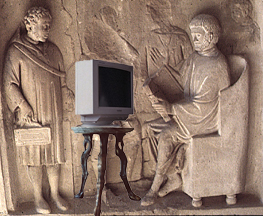
This page summarizes the way that two 1998 Latin courses using the resources of VRoma met the Standards for Classical Language Learning:
EL: Elementary Latin, taught by Barbara McManus at The College of New Rochelle in New York.
AL: A collaborative course in Plautus's Aulularia, taught by Judith de Luce at Miami University in Oxford, Ohio and by Susan Bonvallet at the Wellington School in Columbus, Ohio.
1.1 Students read, understand, and interpret Latin or Greek.
EL: Using the MOO and the online vocabulary and grammatical aids, the students worked together to read and translate Aesop's fable of the Lion and the Mouse.
AL: The students interpreted a Roman comedy while reading it in Latin.
1.2 Students use orally, listen to, and write Latin or Greek as part of the language learning process.
EL: The students wrote Latin sentences as dialogue for the Latin-speaking robots, Urbana Mus and Rusticus Mus, that they had created.
EL: The students used the MOO mail system to correspond in Latin with a high school Latin student who had visited their room and created a lion robot, Leo Ferox.
EL: the students drafted a story line for a romance starring Urbana and Rusticus and then wrote the entire story in Latin.
2.1 Students demonstrate an understanding of the perspectives of Greek or Roman culture as revealed in the practices of the Greeks or Romans.
2.2 Students demonstrate an understanding of the perspectives of Greek or Roman culture as revealed in the products of the Greeks or Romans.
AL: The students explored Roman culture by looking at one "product," Roman comedy, which grew out of Greek New Comedy yet is peculiarly "Roman."
3.1 Students reinforce and further their knowledge of other disciplines through their study of classical languages.
3.2 Students expand their knowledge through the reading of Latin or Greek and the study of ancient culture.
AL: The students expanded their knowledge of Latin and of Roman culture not only because they read in Latin, but also because their preparation of the commentary required them to research and write about many aspects of Roman culture.
4.1 Students recognize and use elements of the Latin or Greek language to increase knowledge of their own language.
EL: The process of writing the Latin dialogue, mail messages, and story prompted the students to reflect on the differences between English and Latin, as they realized that they could not simply substitute Latin for English words but had to rethink the entire sentence to figure out how a Roman would express the idea.
4.2 Students compare and contrast their own culture with that of the Greco-Roman world.
EL: While translating Aesop's fable, the students realized that a literal translation reflecting the style and emphases of the medieval Latin version would not appeal to modern students, so they produced a second, more freely rendered English version that they thought would convey the ideas in a more modern idiom.
AL: The students completed several projects which required that they compare and contrast their own and Roman culture; in one project, for example, they determined what is "funny" now and what was "funny" for the Romans.
5.1 Students use their knowledge of Latin or Greek in a multilingual world.
EL: The students were quite intrigued by the opportunity to correspond in Latin with a student from another country who was also studying the language; their exchange included references to Tolkien (when they asked why his VRoma charactername was Mandos) and to the Arabic language (when he told them that his real name, Asad, meant "lion" in Arabic).
5.2 Students use their knowledge of Greco-Roman culture in a world of diverse cultures.
AL: Using Email and the MOO, the students developed and maintained a community of those studying the Aulularia and Roman comedy, including students at both schools, their instructors, and Timothy Moore at the University of Texas-Austin.